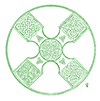 The EarthSpirit Newsletter Lammas 96
The EarthSpirit Newsletter Lammas 96
The Waters of Midsummer
by Anne Lafferty
Midsummer is strongly connected with water and there are many beliefs and practices involving water that are associated with this time of year. Folklore being what it is, there are some apparent contradictions in these beliefs. In most of Europe, Midsummer was either a time when you specifically went into the water of a time when you specifically did not. The belief that bathing in natural bodies of water was beneficial at this time seems to have been more widespread.
The most usual reason for bathing was that water was believed to have healing qualities (both curative and preventive) at Midsummer. In Germany, bathing then was thought to be particularly good for one’s legs. Eye problems that affected vision were treated with dew collected at this time. In Morocco, people washed their livestock in natural bodies of water. In Russia, groups of women bathed at midsummer to attract rain. They not only went into the water themselves, but took with them an image of John the Baptist (whose day this is in the Christian calendar) and briefly held it in the water.
The water connections are not always positive. In Germany and some other areas of Europe, various bodies of water were believed to want to take one or more human lives on this day. For this reason bathing was to be avoided. Apparently, this desire to kill people was often attributed to a spirit connected with the water. The spirit associated with the Neckar River was believed to go so far as to imitate the cries of a drowning person, so as to attract potential victims. In some areas, the wish to cause people to drown was attributed, rather oddly, to John the Baptist.
Underlying both these sets of beliefs are the ideas that water is particularly important at Midsummer and that everything magical, supernatural or otherworldly is heightened or augmented at this time. This ambiguity in the beliefs about water probably reflects the fact that the forces of nature need to be treated with respect. Water can, in fact, be dangerous, if appropriate care is not exercised while bathing or swimming. Bathing was not the only tradition connected with bodies of water at this time. Often flowers would be used to decorate wells or thrown directly into water. In some places it was customary to throw people into the water. Boating was another midsummer tradition.
In Austria, small lanterns were created from eggshells and they were put to float on the Danube. Another practice traditionally associated with this day is divination. Many modern Pagans would probably perceive divination to be a watery activity, in any case, since it is an intuitive process, but a number of the forms of divination practiced at this time involved water. Putting egg white or perhaps some molten lead into water was a fairly widespread practice. The shapes the egg white or lead took were used as the basis of the reading. Using water as a focus for scrying was another Midsummer custom. Rather less directly, this time was especially good for cutting divining rods, whether they were intended to find water or valuables.